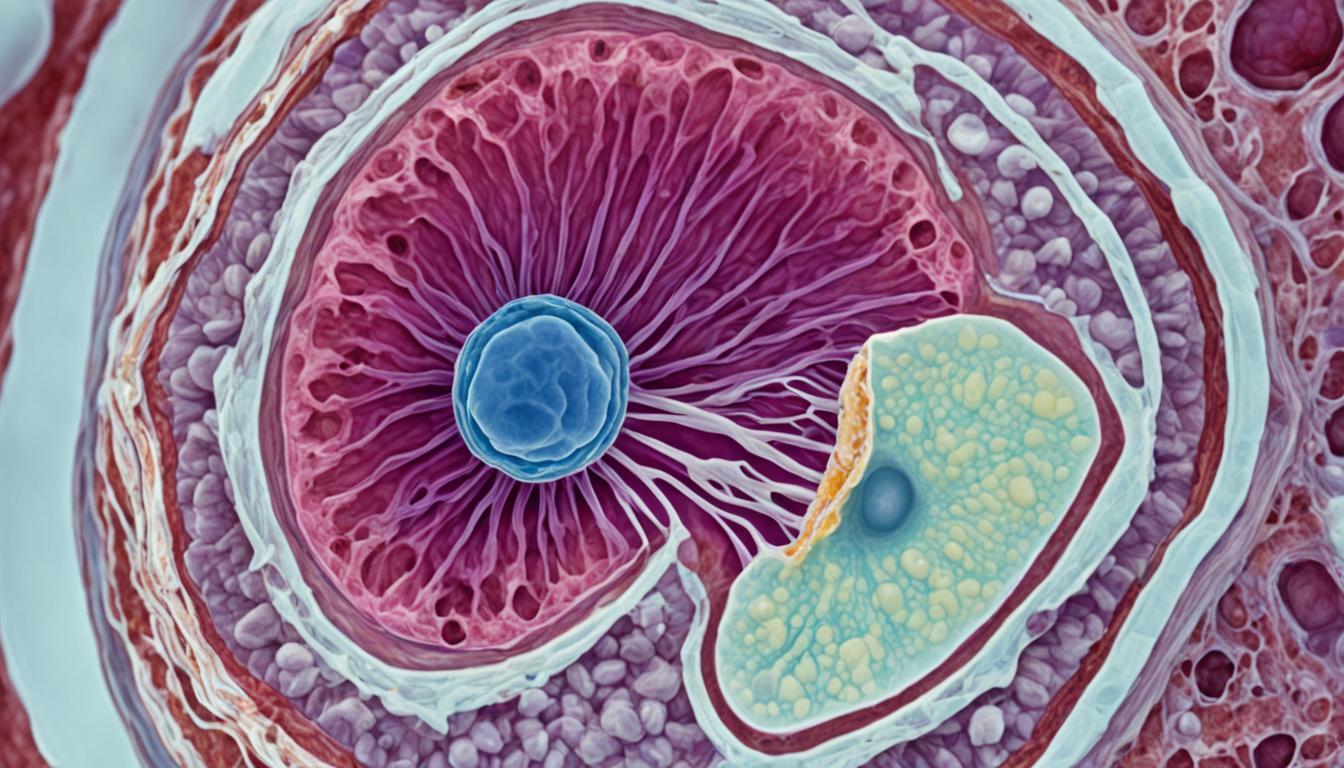Breast cysts are often found in women. They are a top reason for breast masses or symptoms. These cysts can be without symptoms or cause lumps, pain, or a discharge from the nipple. Studies show that many women have had fibrocystic breast disease at some point in their lives, between 70% and 90%. The true cause of breast cysts is not clearly known, but they might be linked to issues in the development and changes in the breast over time.
Usually, breast cysts are not cancerous and don’t raise the risk of breast cancer. Doctors check for breast cysts by doing a physical exam and using tests like ultrasound or mammography. They might also do a biopsy to look at tissue from the cyst. Treatment can involve just watching the cyst, draining it with a needle, or rarely, surgery. Stem cell therapy is a new and hopeful way to treat breast cysts.
Key Takeaways:
- Breast cysts are a common cause of breast mass or breast symptoms in women.
- They can be asymptomatic or present with lumps, pain, or nipple discharge.
- Most breast cysts are benign and do not increase the risk of breast cancer.
- Diagnosis is typically done through clinical evaluation, imaging, and histopathology.
- Treatment options include observation, aspiration of fluid, and surgical removal.
- Stem cell therapy is an emerging treatment option for breast cysts management.
Types and Diagnosis of Breast Cysts
There are many types of breast cysts, each with their own characteristics. It’s important to know about these to tackle breast cysts. Knowing these types can lead to better management.
Types of Breast Cysts
Three main types of breast cysts exist:
- Simple cysts: These are benign, filled with fluid, and very common. On tests, they usually look smooth and round.
- Complicated cysts: They have solid material and fluid, often with notched edges. They might worry doctors more than simple cysts.
- Complex cysts: These contain a solid part and a fluid part. Additional testing is often needed to check if the solid part is cancer.
It’s good to remember that most breast cysts are not cancerous. But, sometimes, more tests are needed to be certain.
Diagnosis of Breast Cysts
To diagnose breast cysts, doctors use imaging tests. The main ones are ultrasound and mammography.
Breast Ultrasound: Ultrasound is top for checking out breast cysts. It makes images with sound waves to see inside the breast. This helps tell between different types of cysts and plan the right treatment.
Breast Mammogram: Mammograms are X-rays for the breasts, often used for those over 35. They are good at spotting microcalcifications, tiny calcium bits, which can hint at certain cyst types.
Sometimes, a biopsy is needed to check if a complex cyst has cancer. A biopsy is when a small piece of the cyst is taken for further testing.
The mix of talking with a doctor and using tests is key to diagnose breast cysts well. This helps doctors choose the best care for every person.
| Type of Breast Cyst | Characteristics |
|---|---|
| Simple cyst | Benign fluid-filled cyst with a smooth and round appearance |
| Complicated cyst | Contains solid material along with fluid and may have irregular edges |
| Complex cyst | Solid mass with fluid around it, further testing needed to determine if the solid mass is cancerous |
Treatment and Management of Breast Cysts
Most breast cysts go away without needing treatment. But, if they cause pain, treatments can help.
Home Remedies for Breast Cysts
To ease a painful breast cyst, you can try simple home remedies:
- Apply heat: A warm compress or warm shower can soothe pain and lessen swelling.
- Wear a supportive bra: A fitting, supportive bra lowers cyst movement and eases discomfort.
- Take over-the-counter pain relievers: NSAIDs like ibuprofen reduce both pain and swelling.
Aspiration of Fluid
If a breast cyst is big and hurts a lot, your doctor might suggest draining it. They’ll use a needle and syringe to remove the fluid. This can ease pain and make the cyst smaller.
Surgical Removal of Breast Cysts
For persistent, painful, or worrisome cysts, surgery might be needed. This process, excision, removes the cyst under anesthesia. It’s considered when other treatments don’t work or if there might be cancer.
Regular Screenings and Follow-Up
If you get cysts often, staying up to date with screenings is crucial. Tests like ultrasound and mammography watch for changes. If something looks wrong, a biopsy can tell if it’s cancer.
Prevention of Breast Cysts
There isn’t a sure way to prevent cysts. But, changes in habits could manage them better:
- Less coffee and tea: Some findings propose cutting back on caffeine to ease cyst issues.
- Using hormonal birth control: For those whose cysts come with their period, this might control hormone spikes and cyst growth.
Conclusion
Breast cysts are harmless lumps in the breast commonly found in women. They are usually part of a condition called fibrocystic disease. Doctors diagnose them through check-ups, imaging tests like ultrasound or mammography, and by looking at tissue samples. Most of these cysts go away without needing any treatment.
But for those causing pain or discomfort, there are ways to help. Using heat, wearing a supportive bra, and taking pain relievers can make things better. Doctors might also drain the fluid from them, which can provide relief. Sometimes, a surgery is needed if the cysts keep coming back or are very big.
Recently, stem cell therapy has shown some promise for treating breast cysts. This method uses the healing power of stem cells to repair the breast tissue. Still, there’s more to learn about its effectiveness through more studies and tests.
It’s key for women with breast cysts to have regular check-ups and screenings. This way, any changes can be spotted early. By being proactive, women can take good care of their breasts and their health.

